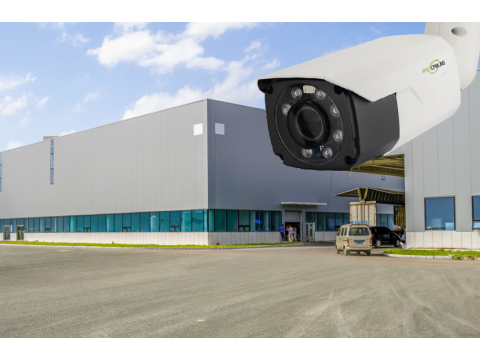Surveillance Solutions for Large Areas
Large-area surveillance presents unique challenges, including camera placement, equipment selection, and power supply setup. These challenges vary depending on whether the area is indoors (e.g., warehouses) or outdoors (e.g., parking lots, open fields).
Indoor Surveillance for Large Areas
For indoor spaces like warehouses or factories, surveillance camera placement is straightforward:
- Mount cameras on walls, beams, or support structures.
- Use existing infrastructure (e.g., trusses, ceilings) for cabling.
- Opt for wide-angle cameras to reduce the number of devices needed.
Cabling inside such spaces can follow walls, ceilings, or even be suspended on a cable string. These setups minimize additional structural changes while providing comprehensive coverage.
Outdoor Surveillance Challenges
For outdoor areas, surveillance solutions must address issues like camera mounting and expansive coverage needs.
Perimeter Control
Mounting cameras along the property's perimeter is a common solution. This approach ensures both perimeter and internal zone coverage. However, it requires attention to:
- Camera Placement: Cameras should be mounted high on brackets facing inward to minimize vandalism.
- Cable Protection: Use metal conduits or underground wiring for secure cabling.
Centralized Camera Setup
A cost-effective option for open spaces involves mounting cameras on building exteriors. However, this limits viewing angles and may require:
- Telephoto Lenses: For distant areas, though they narrow the field of view.
- Multiple Cameras: To avoid blind spots, increasing system size and cost.
Wireless Surveillance Systems
Wireless cameras are ideal for large areas with existing power sources, such as perimeter lighting systems. Benefits include:
- Simplified Installation: Eliminates the need for extensive cabling.
- Reduced Costs: No need for additional infrastructure like trenching or conduits.
- Flexibility: Easy to relocate cameras as monitoring needs evolve.
Challenges with Wireless Systems
- Signal Interference: Walls and long distances can reduce transmission quality.
- Weatherproofing: Ensure outdoor wireless cameras are durable against elements.
Powering Surveillance Systems
Power sources for cameras in large areas are critical for uninterrupted functionality. Consider these strategies:
- Integration with Lighting Systems: Utilize existing outdoor lighting for power.
- Solar Panels: Ideal for remote locations without access to grid electricity.
- Battery Backup: Ensure cameras remain operational during outages.
Advanced Camera Options
For extensive properties, consider PTZ (Pan-Tilt-Zoom) cameras:
- 360° Coverage: Single PTZ cameras can replace multiple static cameras.
- Remote Operation: Adjust angles and zoom remotely for dynamic monitoring.
Lighting Considerations
For large-area monitoring, sufficient lighting is essential for clear footage:
- Avoid relying solely on infrared (IR) lighting—it may not effectively cover large spaces.
- Install floodlights or motion-activated lighting for optimal visibility.
Conclusion
Designing a surveillance system for large areas requires careful planning, from camera placement to power solutions. Whether monitoring a large warehouse, a factory, or an expansive outdoor space, combining perimeter security, wireless technologies, and advanced cameras ensures optimal coverage and system efficiency.
Invest in a tailored solution to safeguard your property and achieve peace of mind.

